
Fly Fishing the Nipigon

The Nipigon is a large, deep river with a heavy flow rate.The banks are usually steep and bolder strewn with trees and brush tight to the banks. It is not conduscive to your usual dry fly casting methods with a pretty back swing. Instead, The trick is to get down to their lies among the rocks, without getting hung up. Sink tips or shooting heads fit the bill as casting full sinking lines all day will wear you out in this current. A 7 or 8 weight rod is best suited.
Like most trout, Nipigon Brookies seek their food and protection by holding in lies that offer protection from predators yet allow them to ambush their prey. They seem to prefer cobblestone bottoms and banks that break the current flow but still allow them the opportunity to charge out into the heavier current from the depths using their large square tail for power.
Casting method #1
The typical wet fly swing works by making an across-stream cast, immediately mending slack into the line (usually an upstream mend) to allow the fly to sink, and following the drift of the line (or swing) with your fly rod.
Casting method #2
The Borger Jerk Strip in another method that works well on the Nipigon.
Casting method #3
The simple lazy method is my prefered choice. Cast out your line parallel to the river bank, give a quick up stream mend then let the river's current do the work. I use this method from a boat and with the motor still in forward, let the current drag the boat down stream and sink the line like back trolliing. When a fish hits, you will know it.
A rare photo for the Nipigon River...

...not because of the waders, wading boots and a clean shirt, rather the river has very few locations that one can safely fly fish from shore. The Nipigon is noted for its steep banks, fast current and lack of good wading opportunities. Most of the fishing is done from a boat on the different stretches of the river. The long handled, carbon fiber net by Fishpond has a soft, rubber netting conducive to healthier releases.
Nipigon fish length to weight chart
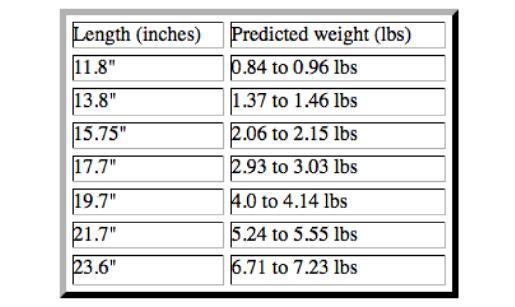
While the chart above was specifically designed for Nipigon Brook Trout based on actual Length/Girth/Weight measurements. I have noticed two distinct body shapes in the Nipigon system. The lake variety appears longer and leaner, while the river has both this long, lean body type AND a shorter, rounder, "footbal" shaped fish.
The traditional weight formula that is often used is: weight (lbs) = length(inches) X girth(inches)^2 / 800. Research out of British Columbia based on Steelhead and Salmon species challenges this formula with new data. A site called: Fly Fishing Research has revised the formula to be multiplied by 690,rather than 800, stating it is a more accurate representation.
I could not resist the challenge to test this new formula against the Nipigon Brook Trout which are known to exceed the traditional formula. Since I had actual Length/Girth/Weight measurements for Nipigon Brookies, I applied their revised formula to see how accurate it was compared to the actual weight of each fish. Using the 690 number, the weights came out accurate within a few ounces for each fish and better represented the true estimate of weight. When I have more time, (non fishing season) I'll post my data and see if I come up with the same 690 number.
The Brook Trout of the Nipigon River, Lake Nipigon and indeed the Coasters of Lake Superior defy the usual trout weight formulas with their stout "girth-to-length" proportions. A special formula was developed by Nipigon angler Kurt Melancon from Minneapolis. While I re-created the Nipigon Brook Trout Weight Table listed below, the true credit goes to Kurt and fellow anglers Bill Boote and Scott E. Smith, along with others who gathered the actual measurements of girth, length and weight as first displayed in Scott's book:
Ontario Blue Ribbon Fly Fishing Guide.
Off the Charts
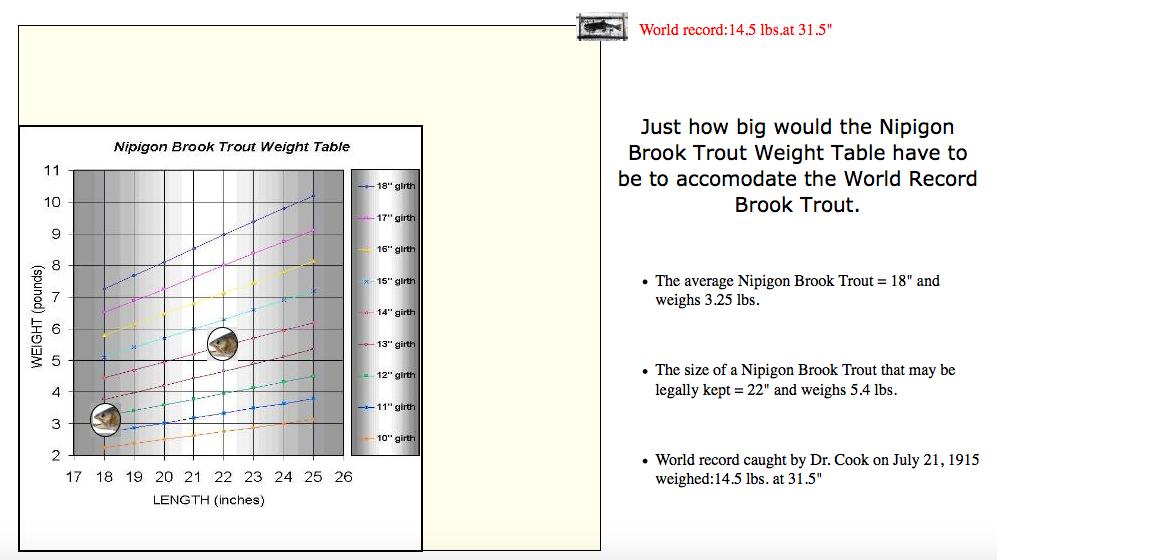
Catch and Release
"A fish is too valuable to only be caught once"
Lee Wulff
Catch and release is a growing preference among anglers. MNR stats indicate that only 5% of anglers reported that they don't practice at least some form of "C&R". While research indicates a mortality rate of 16% for all types of fish, conditions and fishing styles, the rate jumps, sarcastically, to 100% if you keep the fish.
I have chosen to practice total C&R for the Nipigon brook Trout for a variety of reasons, and my experience and records I keep of all releases for the MNR Tagging Program indicate that catch and release works if done properly. My data indicates, that in some fishing "hot spots" recaptures can be as high as 40%. Granted, if I caught a world record brook trout, I might consider keep it, after all...I'm human!
"A fish taken is a fish gone forever"
Measured: 22.25" x 14.5" girth. weighed: 4lbs. 6oz
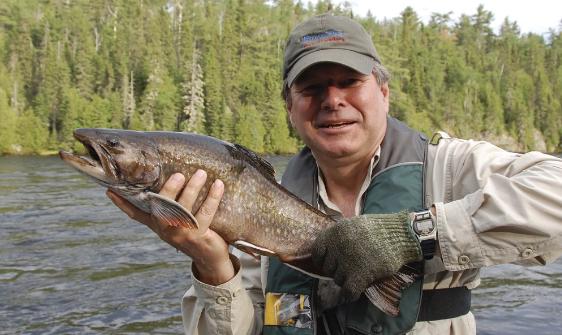
It also grew conciderably during those two years. It grew 4.5" and gained almost 2 lbs.
Interesting to note that I'm wearing the same clothes. Hopefully, they have been washed. Reminds me of that saying,
"Old fishermen never die, they just smell that way."
Looks like I gained a little weight too.
Guidofisherman
Measured: 17.75" x 11"girth, weighted: 2lbs. 13oz
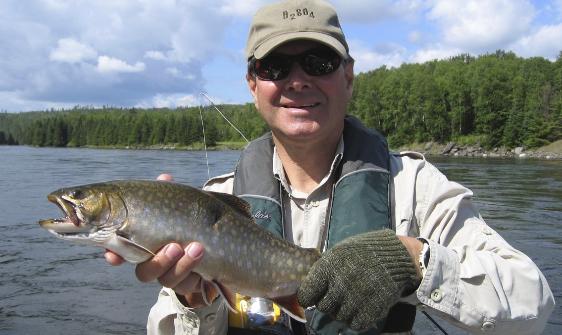
Catch and Release Works
Two photos taken two years apart, & obviously of the same fish. Same general location as these fish are usually territorial.
Notice the scar along its back. Your guess is as good as mine, but I think it is probably from a prop.
Increase in damage to fish

Since the 2005 regulation change to 22", almost 95% of all fishermen indicate they use some form of "catch and release". Because more fish are being returned, the data indicates there is an increase in the damage these fish display. Damage such as hooks left imbedded, loss of maxilla plates and torn mouths such as the photo below.
Note the damaged maxilla plate from a previous injury

Catch and Release Angling (pdf)
• only 5% of anglers surveyed reported that they did not practice catch-and-release to some extent
• both by anglers and fisheries managers, assume that fish which are released actually survive the experience.
• the average mortality associated with catch-and release angling was 16.2%.
• hook type affected the success of catch and release
• catch-and-release mortality can be reduced through the use of artificial bait.
• While the increased mortality associated with deep hooking is understood, it is less clear as to whether it is better to cut the line of deeply hooked fish or try to remove the hook, potentially risking further injury and increased air exposure to the fish.
• the probability of mortality increased from 16% with no bleeding to 40% with heavy bleeding.
• When fish are caught and retrieved quickly from deep water, injury may result from depressurization.
• Evidence suggests that catch-and-release mortality is directly related to water temperature, with mortality increasing at extreme temperatures.
• Of the four types of landing net mesh types compared (rubber, knotless nylon, fine knotted nylon and coarse knotted nylon), the knotted mesh types resulted in greater injury and mortality than rubber or knotless mesh.
• These studies demonstrate the detrimental effects of air exposure, and highlight the need to reduce handling time and air exposure during catch-and-release.
• The length of time required for fish to recover from catch-and-release practices may help explain why mortality is often delayed until after release.
• Fish size is thought to be related to catch-and-release mortality because larger fish are more difficult to handle, thus higher mortality may be expected with increased fish size.
Lord of the Flies
Popular flies for 'Fish'n the Nipigon'
Green Butt Monkey
Originated by Scott E. Smith and Bob Linsenman
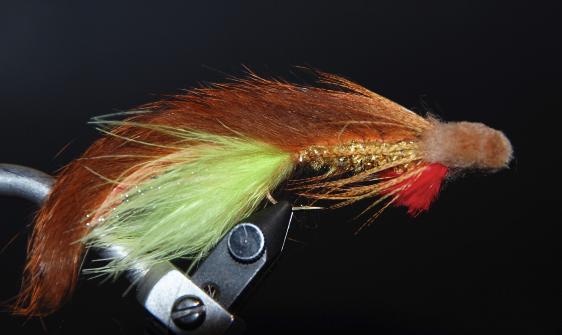
- Hook: TMC 300 or TMC 5236 in sizes 2 or 4
- Thread: 3/0
- Tail: Yellow marabou plus six strands of gold Krystal Flash
- Body: Gold sparkle chenille
- Rib: Medium copper wire
- Wing: Rust rabbit strip (olive rabbit strip)
- Pectoral fins - olive mallard flank
- Gills: Red wool (red marabou)
- Collar: Pheasant rump
- Head: Spun and clipped ram's wool (tan) (olive)
Olive Borger Strip Leech
Nipigon River pattern by Bill Boote
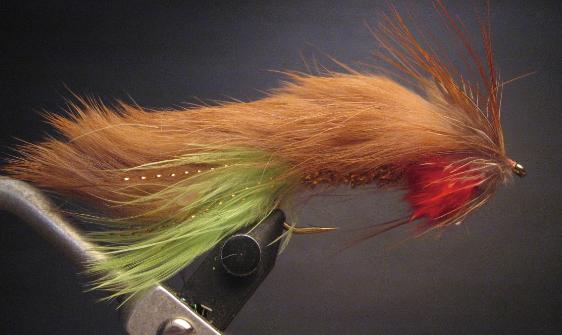
- Hook: Daiichi 2220, sizes 2-4
- Thread: Uni-Thread 3/0 monocord
- Tail: Chartreuse marabou with several strands
- of Krystal Flash ( gold or copper)
- Rib: gold or copper chenille (lead underbody)
- Wing: Olive/grizzly rabbit strip
- Throat: red marabou
- Hackle: Olive Ring-necked pheasant rump feather
Rainbow Smelt
Designed by Guidofisherman
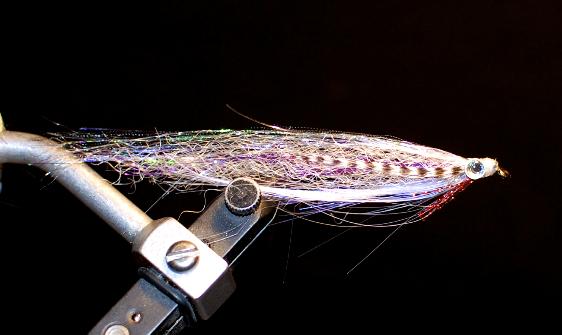
- Hook: Trailing hook wired to eye
- Thread: Uni-Thread 3/0
- underwing: Ice Dub Shimmer Fringe (UV Pearl), white
- Body: Strung Fuzzy Fiber, white
- Inside body cavity: Purple Krystal flash
- Wing: Grizzley hackel
- Overwing:Hollow Fusion, black/green
- Throat: red krystal flash
- Holographic eyes
Rainbow Smelt is actually an invasive species to the Great Lakes and the Nipigon. Brook Trout have adapted to it as a food source along with the more traditional Sculpin (Cockatouche).
I prefer a single, trailing, short shank hook on this pattern to deal with short strikes and to lessen the torque on the hook when fighting these powerful fish.
Jig Fly
sold by "Mighty Mitch and Jungle Joe"
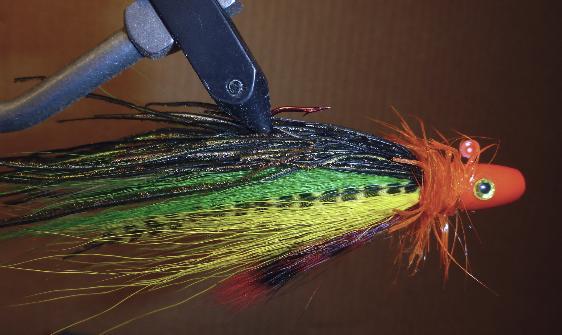
Jigs are highly versatile and used with a spinning outfit when you can't get your fly line down or your casting arm needs a rest. I prefer to cast towards the bank or up on the reef and remember to fish close to the bottom. Be prepared to lose a few to the boulders. These attractor patterns are retrieved fairly fast and don't slow down if you see a brookie about to hit as they seem to sense something is wrong and simply veer away....But it gets the heart pumping.While I don't sell my jig flies, a local company below has modified the original Dan Klatt jig fly pattern.
Mighty Mitch & Jungle Joe's Jig Flies
For Styles and Pricing Contact: Joe Kostecki
Email: cjkostecki@shaw.ca
Terrace Bay, Ontario
(807) 825-9569
Stonefly
Early Brown Stonefly, 14-16 hook, Midday Hatch, Early April-Mid May
Early Black Stonefly, 18-22 hook, Midday Hatch, Mid March-Early May
Salmonfly, 4-2 hook, Midday Hatch, Mid May-Early July
Yellow Sally, 12-14 hook, Evening Hatch, Early June-Mid August
Little Yellow Stonefly, 10-12 hook, Evening Hatch, Early June-Late July
Great Brown Stonefly, 6-8 hook, Afternoon and Evening Hatch, Early June-Late July
Eastern Golden Stonefly, 6-10 hook, and Evening Hatch, Early June-Late July
Eastern Creeper, 6-10 hook, Afternoon and Evening Hatch, Early June-Late July
Credit for the creation of this hatch chart goes to Fred Dean.
Mayfly
Brown Spinner, Black Quill, 14-18 hook, Midday Hatch, Early April-Late May
Blue Quill, 14-18 hook, Midday Hatch, Early April-Mid May
Early Blue-Winged Olive, 16-18 hook, Midday Hatch, Early April-Late May
Light Cahill, 14-18 hook, Midday Hatch, Mid April-Late June
March Brown, Gray Fox Varriant, 10-12 hook, Midday Htch, Early April-Late May
Mahogany Dun, 10-14 hook, Afternoon Hatch, Late May-Early July
Eastern Gray Drake, 8-10 hook, Evening Hatch, Early June-Early July
Brown Drake, 8-10 hook, Evening Hatch, Late June-Mid July
Giant Drake ( Hex ), 8-4 hook, Evening Hatch, Late June-Mid July
Speckled Spinner, 10-14 hook, Evening Hatch, Late June-Late August
Caddis
Little Tan Short-horn Sedge, 12-14 hook, Evening Hatch, Early April-Late August
Rush Sedge Caddis, 6-10 hook, Midday Hatch, Early April-Early July
Smoky Wing Sedge, 14-16 hook, Midday Hatch, Late April-Late May
Scaly Wing Sedge 14-16 hook, Midday Hatch, Early May-Early July
American Grannom, 14-16 hook, Evening Hatch, Early June-Mid July
Spotted Sedge, 14-16 hook, Evening Hatch, Early June-Mid July
Dark Blue Sedge, 14-18 hook, Evening Hatch, Early June-Mid July
Little Black Sedge, 14-18 hook, Evening Hatch, Early June-Mid September
Green Sedge, 12-16 hook, Evening Hatch, Early June-Late August
Great Dive-bomber Sedge, 8-12 hook, Evening Hatch, Late June-Early September
White Miller, 8-12 hook, Evening Hatch, Early August-Late September
Great Orange Sedge, 8-12 hook, Afternoon Hatch, Early August-Mid October
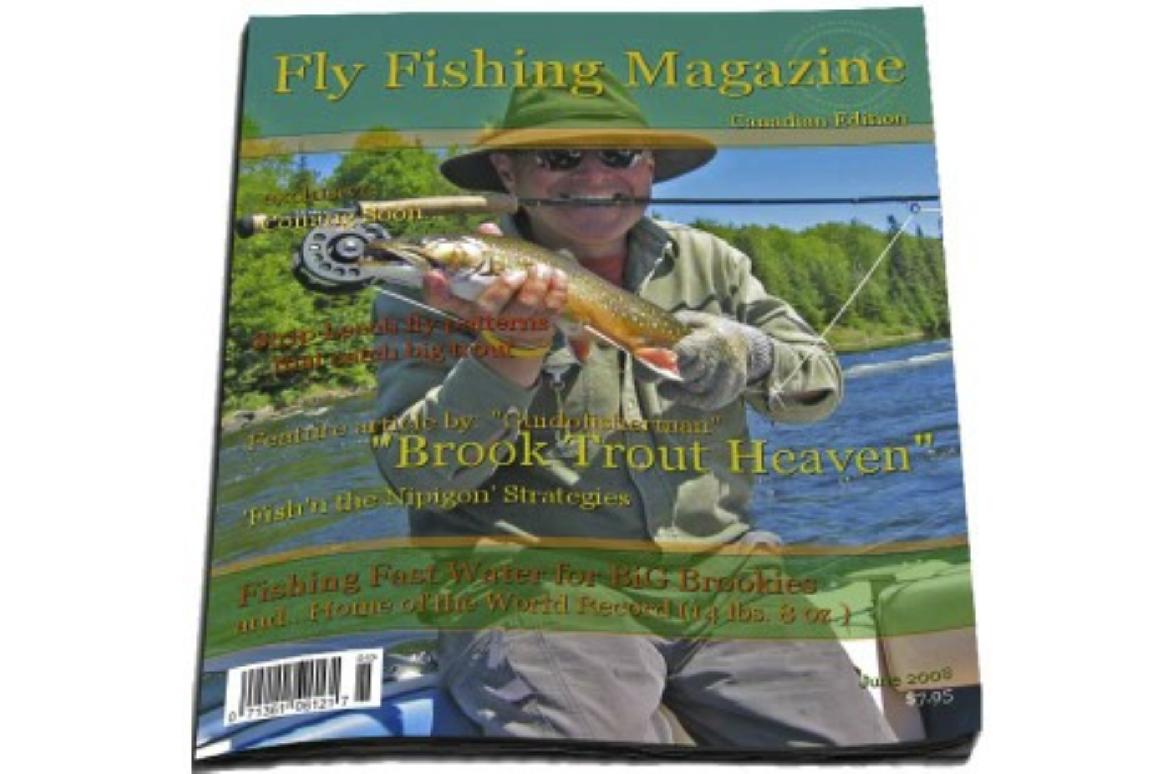
I'm a true fisherman...I can not tell a lie! Yea right.
The Fly Fishing Magazine cover was made with Photoshop.

